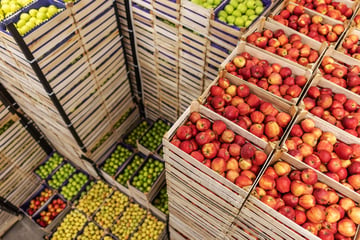At the heart of any healthy food organization is strong supplier management, enabling businesses to meet production schedules, ensure regulatory compliance, and establish better supply chain resiliency in the midst of disruption. As a food manufacturer, you may already have a set of trustworthy suppliers that you rely on for all of your products. However, as the COVID-19 pandemic demonstrated, situations can change very quickly – whether it be due to a raw material shortage, economic volatility, or a new allergen regulation – and as such, you need to be prepared to bring on new suppliers quickly and efficiently.
6 Steps to Onboarding New Suppliers
What exactly does a complete onboarding process look like? Luckily, it only takes six or so steps:
1. Review the supplier's food safety program:
Before accepting a new supplier, you should review their food safety program to ensure it meets the required compliance standards and is aligned with your expectations for food safety. This includes taking a look at documentation that outlines their safety and quality procedures, including their food safety plan, good manufacturing practices (GMPs), and allergen control measures. You may even want to consider conducting a site visit to ensure those quality standards are indeed being met. Reviewing this information from the start is crucial to avoid lapses in food safety that may have severe consequences for both the consumer and your business.
2. Track and review completed compliance documents:
Both the food company and supplier need to complete compliance documents, such as supplier agreements for food safety, and other to-dos to establish clear expectations and determine the responsibilities of each party. It’s also important to obtain any certifications, permits, and licenses from the supplier to ensure they meet US regulatory compliance and see their proof of insurance (better safe than sorry!). Taking the time to complete and review compliance documents at the start can help to prevent any future misunderstandings or disputes later down the line that might negatively impact the partnership.
3. Establish open lines of communication:
To ensure a smooth partnership, make sure you establish open and honest lines of communication with the new supplier from Day 1. The supplier should have a dedicated contact person who can answer any questions or address concerns related to the product that you would need to know, particularly for quality and safety concerns or traceability efforts. You might also want to confirm communication channels – is this dedicated person easiest to reach by phone or through a message on a supplier management platform? Who can they contact as a backup? By designating a dedicated contact person, and even a backup chain of command, and establishing clear communication channels, both parties will be able to respond to a food safety issue quickly and efficiently. It will also help resolve any logistics, planning, or production issues that may arise.
4. Outline processes and procedures:
Just as you set clear expectations for compliance and communication, make sure you’ve taken time to outline your expectations for certain processes and procedures. Each business has its own methods for quality assurance and safety or logistical management, so you can’t expect your new suppliers to automatically know or understand your internal processes. Take time to outline these procedures from the start!
What is the supplier’s role in the audit process, and when do they need to submit documentation, and to whom? How is your supplier preparing for FSMA 204 documentation down the line, if they work with high-risk foods? While perhaps a time-intensive task now, it will reduce the risk of future (and potentially costly) errors later down the line.
5. Update product labels and formulas:
If a new supplier results in a change in your products’ ingredients, you’ll need to make sure to update product and allergen labels and formulas accordingly to ensure compliance. It’s also important to make sure the new supplier can provide sufficient documentation on their allergen control measures – if there’s a potential for allergen cross-contact – to ensure the safety of the product. Remember: inaccurate labeling could put consumers and your business at risk of a costly product recall, so as you think through your supplier onboarding steps for accurate labeling, consider investing in a food labeling software that can make this step a bit easier.
6. Commit to continuous improvement and collaboration.
Your partnership with your suppliers doesn’t end after the onboarding process is complete – these partners are now ultimately an extension of your business. Following the onboarding process, make sure that your suppliers know your commitment to a strong, collaborative, and continuously improving partnership. A partnership built on open communication, honesty, and collaboration will benefit all parties involved.
Leveraging FoodLogiQ Compliance Technology
While onboarding new suppliers may seem like a ton of boxes to check and processes to review, it’s critical to ensure compliance with regulations and establish a successful partnership for years to come. Luckily, there are also supplier management solutions that can help streamline and simplify this process.
Trustwell’s FoodLogiQ Compliance solution provides businesses with a streamlined supplier management process in a single, intuitive dashboard, from documentation review and management to completing and tracking supplier audits or assessments. It can also provide an avenue to onboard suppliers virtually in the event of another global disruption. Connect with our team at Trustwell today to learn more about our supplier onboarding and compliance solutions.
Other posts you might be interested in
View All Posts
Food Safety
10 min read
| March 29, 2023
Supplier Management Best Practices and Tips in the Modern Food Era
Read More
Food Industry
8 min read
| June 29, 2023
How to Harness Supplier Data to Improve Food Safety Efforts
Read More
Food Labeling
9 min read
| September 7, 2023

